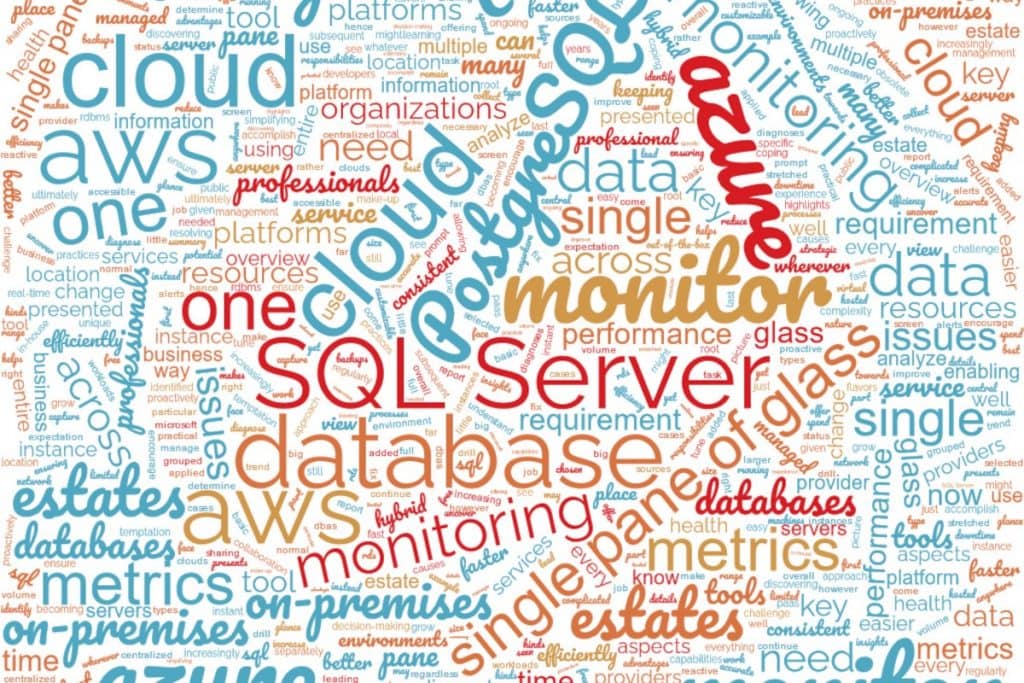Why monitoring server estates from a single pane of glass is key

The last few years have seen a big change in the size, make-up, and nature of database estates. Data is growing both in volume and complexity, it is now normal to have workloads as well as data in multiple public clouds, and organizations are increasingly using different kinds of databases for different use cases.
This trend towards hybrid environments highlights the need for database professionals to monitor their server estates so that they can see everything from local servers and virtual machines to cloud instances and services, whatever the database type or platform. Having one single view of a hybrid environment is key to keeping processes running efficiently, simplifying management, and proactively resolving issues faster and easier.
The challenge they face is the requirement to capture and monitor metrics that are unique to particular cloud service providers and RDBMS platforms, and continue to monitor on-premises metrics. All while keeping a consistent experience across platforms and allowing DBAs and developers to drill down into details when necessary.
Data professionals also need to know how to identify and diagnose issues that are specific to each cloud provider. This is further complicated because some basic aspects of monitoring are obsolete with cloud services, and many other aspects remain but are different.
The cloud service chosen will in part determine the subsequent responsibilities of database professionals. If, for example, a PaaS offering like Microsoft Azure DB or a Managed Instance such as Amazon RDS is selected, there will be no need to manage backups. However, there will still be a requirement for real-time monitoring and ensuring ongoing performance, and information about which metrics to monitor or tune will be different for each cloud service provider.
This might prompt a temptation to monitor on-premises estates and cloud environments separately, but the approach may not be practical, given the limited resources most organizations are now coping with. There is little time to spend learning how to use multiple tools or go into different tools to collect and analyze information and metrics from several disparate sources regularly.
The advantages of single pane of glass monitoring
Instead, it is better to have an instant overview of every database and instance, wherever they are hosted, in one place, at one time, presented in the same way. Hence the growing expectation for monitoring tools to come with out-of-the-box monitoring capabilities for the metrics of leading cloud providers as well as on-premises databases, presented at a glance from a single pane of glass.
They should also offer all of the data needed to analyze and report on the health of an entire database estate in one central location in the same way. This will lead to faster, more accurate diagnoses and, ultimately, better decision-making right across the business. Using a single tool to accomplish this task helps make the job of every data professional far easier by enabling them to be proactive rather than reactive.
The advantages of Redgate Monitor
This is where a tool like Redgate Monitor can help. Redgate Monitor allows organizations to manage their entire SQL Server and PostgreSQL estate from a single pane of glass. Offering a global overview from a central web-based interface, it lets users see all of their SQL Server and PostgreSQL instances, availability groups, clusters, and virtual machines in one place, regardless of location or restrictions.
Whether databases are hosted on-premises, in the cloud or both, it provides the answers to the health of an estate and alerts any potential issues before they affect users. With instant problem diagnosis and intelligent, customizable alerts, it enables data professionals to:
- Monitor databases on-premises and in the cloud in one place, at one time
- Know about issues first, uncover the root causes, and fix them, fast
- Increase efficiency and free up resources for more strategic work
- Reduce downtime and improve performance
- Encourage collaboration by sharing insights across the business
Summary
This is just an overview of the increasing need to monitor database estates that are becoming larger and more disparate, across different database types and platforms, yet do so efficiently. Many organizations are discovering that their in-house resources are now being stretched by the requirement to monitor a range of databases both on-premises and in the many flavors of the cloud.
The key is to do so with a tool like Redgate Monitor that presents the full picture, on one screen, accessible anywhere. The centralized view makes it easy to understand the overall health, performance, and status of an entire database estate. The consistent, customizable metrics and alerts also ensure the same best practices are applied, enabling potential issues to be identified and addressed, wherever they are. And, as database estates grow or change, servers can be added, grouped, and managed, regardless of platform, network, or location.
To discover more about single pane of glass monitoring with Redgate Monitor, try the online demo, or visit the solutions page.
Tools in this post
Redgate Monitor
Real-time multi-platform performance monitoring, with alerts and diagnostics